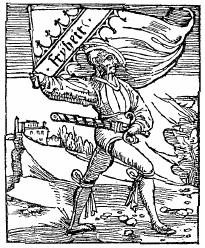.jpg)
|
II. Radical
Reformation
A. Common
Characteristics?
1. Impatience and Urgency
2. Vernacular Literalism
3. Separatism and the Visible Church
4. Optimism and Apocalypticism
Chart: Christoph Erhard's "Ketzer Tafel" (1588)
Map: Major Concentrations
of Anabaptists, 1525-1550
Map: The Travels of Melchior Hoffman
(c. 1495-1543)
B. Varieties of Radical Reformation
1. The Swiss Anabaptists
2. Moravian Brethren and Hutterites
3. Melchiorites and the Münster Episode (1534-1535)
Image: Iconoclasm in Zürich, 1524
Image: The Execution of Felix Manz (1527)
Map: Migrations of the Hutterites, 1546-1874)
Image: Melchior Hoffmann (c. 1495-1543)
Image: The city of Münster (1642)
Image: Siege of Münster (1534)
Image: Execution of the
Münster Anabaptists, 1535
Image: St. Lamberti, Münster
Image: Menno Simons (1496-1561)
Image: The Execution of Maria van Monjou (1552)
C. Who Were the Anabaptists?
Image left: Jan van Scorel (1495-1562) [attrib.], Portrait of David Joris. Kunstmuseum Basel. Image source: WikimediaCommons. Image right: Heinrich Aldegrever (1502-1555?), Jan van Leiden (1536). National Gallery of Art. Image source: Artsy.
Aldegrever was commissioned by the then-Bishop of Münster, Franz von Waldeck to engrave portraits of the principal figures in recently suppressed “Kingdom“ that Anabaptists had established in the city of Münster in 1534. Among them was Jan Beukelszoon van Leiden (1590?-1536), a tailor's apprentice, who by his own account arrived in the city of Münster in 1533, seeking revelation from radical preachers there. In early 1534, Anabaptists took over the city's government, forcing Catholics and Lutherans into exile. After the death of the Anabaptist prophet, Jan Matthys, on Easter Day, 1534, Jan van Leiden was recognized as leader of the “Anabaptist Kingdom,“ over which he reigned until the city was defeated and recaptured by a joint Catholic-Lutheran military force under Bishop Franz von Waldeck in June 1535. Jan van Leiden was captured, hiding in a cellar. On 22 January 1536, he and two adjutants, the former mayor Bernhard Knipperdolling and Bernhard Krechting, an erstwhile priest, were executed on a large platform erected for the purpose on the plaza outside the church of St. Lambert in downtown Münster. The three men were tortured with “glowing tongs” and finally dispatched with a dagger-stab “into the chest of each man” subsequently their remains were suspended in cages from the church steeple. |
.jpg) |
Table: Residence patterns among Anabaptists:
| |
1525-1529 |
1530-1549 |
1550-1618 |
Total |
| Free city |
822 |
22.7% |
517 |
14.0% |
212 |
5.5% |
1,551 |
13.8% |
| Large town |
525 |
14.5% |
441 |
12.0% |
50 |
1.3% |
1,016 |
9.1% |
| Small town |
900 |
24.9% |
483 |
13.1% |
355 |
9.2% |
1,738 |
15.5$ |
| Village |
1,069 |
29.6% |
1,673 |
45.4% |
2,811 |
72.6% |
5,553 |
49.7% |
| Farmstead |
10 |
0.3% |
63 |
1.7% |
27 |
0.7% |
100 |
0.9% |
| Residence unknown |
291 |
8.0% |
510 |
13.8% |
416 |
10.7% |
1,217 |
10.9% |
Source: Claus-Peter Clasen, Anabaptism, A Social History, 1525-1628 (Ithaca, 1972)
|

.jpg)
.jpg)